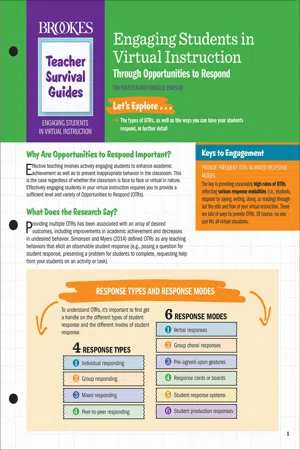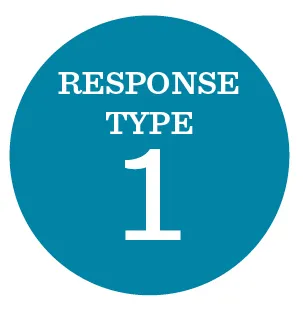
Engaging Students in Virtual Instruction through Opportunities to Respond
Timothy Knoster, Danielle Empson
- 6 pagine
- English
- ePUB (disponibile sull'app)
- Disponibile su iOS e Android
Engaging Students in Virtual Instruction through Opportunities to Respond
Timothy Knoster, Danielle Empson
Informazioni sul libro
Enrollment in virtual and blended schools is on the rise—introducing new challenges with student engagement, social–emotional wellness, and behavior management. Help is here with this laminated quick–guide, one of four concise Teacher Survival Guides on Engagement of Students in Virtual Instruction. Brimming with practical, research–based tips and strategies, this guide unlocks one of the keys to success in online learning environments: active engagement of all students. Teachers will discover how to engage students in virtual instruction by offering a wider variety of Opportunities to Respond (OTRs), a strategy that's been associated with improved academic achievement, student empowerment, and less undesired behavior. Tim Knoster and Danielle Empson introduce the benefits of providing multiple OTRs, the different types and modes for student responses, and how to monitor student engagement virtually. GET THE COMPLETE SERIES: The four Teacher Survival Guides on Engagement of Students in Virtual Instruction are filled with the ready–to–use guidance K–12 teachers need to boost engagement, student wellbeing, and positive behavior in virtual settings. Packed with bite–sized nuggets of insight—including keys to engagement, teaching tips, proven strategies, and FAQs—these laminated, six–panel guides will help any teacher take immediate action to support their students' academic, social–emotional, and behavioral success. Learn more about the other quick-guides in the series: Building Relationships With Students and Caregivers to Enhance Learning Through Virtual Instruction
Engaging Students in Virtual Instruction Through Opportunities to Respond
Addressing Undesired Student Behavior During Virtual Instruction
Domande frequenti
Informazioni
